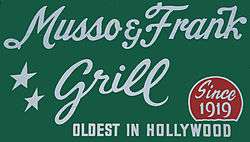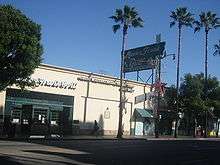Musso & Frank Grill


Musso & Frank Grill is a restaurant located at 6667-9 Hollywood Boulevard in the Hollywood neighborhood of Los Angeles, California. The restaurant opened in 1919 and is named for original owners Joseph Musso and Frank Toulet. The restaurant has been called "the genesis of Hollywood."[1]
History
Musso and Frank, a classic "New York style bar and restaurant,"[2] was founded in 1919 as "Francois,".[3] and was located at 6669 Hollywood Blvd.[4] The restaurant changed its name to Musso & Frank in 1923.[3]
In 1927 the restaurant was sold to Joseph Carissimi and John Mosso. In 1936 Mosso expanded the restaurant to include 6667 Hollywood Blvd.[4] The big room on the East side of the restaurant, opened in 1955, is still called "the new room."[5] The restaurant has kept to this day its original character, which includes high ceilings, dark wood paneling, and red booths.[6] Its waiters and bartenders dress in the same red coats that they've worn for decades.[7] The restaurant is still owned by the descendants of John Mosso and is managed by his great grandson Mark Echeverria.[5]
Due to its status as an iconic Los Angeles restaurant, Musso and Frank has been featured in several notable films including Ed Wood (1994),[8] Oceans Eleven (2001),[9] and Greenberg (2010),[10] in addition to several classic novels such as The Day of the Locust (1939)[11] and What Makes Sammy Run? (1941).[12]
Menu
Musso and Frank has not only maintained its classic decor, but its classic steakhouse style menu,[13] which still includes such anachronistic dishes as Welsh Rarebit, Lobster Thermidor,[6] and the famed chicken pot pie, available only on Thursdays.[14]
Cultural role in the life of Los Angeles
When Musso and Frank opened in 1919, the political and financial life of Los Angeles was centered in Downtown Los Angeles, which was a difficult journey at that time. This made it possible for the restaurant to attract the more bohemian and intellectual clientele who were starting to spend time in Hollywood.[15]
Literature, theatre and politics
By the 1930s Musso and Frank was firmly established at the center of Hollywood's cultural life. Stanley Rose's essential bookstore was right next door to the restaurant, and many of the writers of the hard-boiled fiction that he preferred, who hung out in the back room of the bookstore, spent endless hours in the bar of Musso and Frank; e.g. James M. Cain,[16] John Fante (who frequented the restaurant with famed journalist and historian Carey McWilliams),[17] Raymond Chandler, and Nathanael West.[16] Other literary regulars include William Saroyan, Dashiell Hammett, Erskine Caldwell,[18] Dorothy Parker, William Faulkner,[15] F. Scott Fitzgerald,[19] Elliot Paul,[20] and Donald Ogden Stewart.[21] By the 1940s the restaurant was so firmly identified with the Los Angeles literary scene that aspiring writers, e.g. Charles Bukowski, would drink there in a conscious effort to imitate their role models.[18] Eminent California historian Kevin Starr has said that a list of writers who frequented Musso and Frank resembles "the list of required reading for a sophomore survey of the mid-twentieth-century American novel."[2]
Important Los Angeles progressives and communists were identified with Musso and Frank (and Rose's bookstore as well).[22] Future California congresswoman Helen Gahagan Douglas, famous for being defeated by Richard Nixon in a notably dirty 1950 Senate election, ate dinner at Musso and Frank on her first night after moving to Los Angeles with her husband, actor Melvyn Douglas.[23] Noted actor and CPUSA member Will Geer met regularly at Musso and Frank in the late 1930s and 1940s with a group of young radical writers and actors.[24]
The film industry
From its founding, though, Musso and Frank has been essential in the social life of the Los Angeles film industry.[25] The restaurant kept a separate back room for its film industry clientele,[26] which included not only screenwriters, many of whom are listed above, but actors, producers and directors as well, including Tom Mix, Charlie Chaplin,[24] Harry Warner and his brother Jack,[15] Greta Garbo,[27] Humphrey Bogart, Marilyn Monroe, William Frawley, Douglas Fairbanks, Mary Pickford,[6] Orson Welles,[28] Rudolph Valentino,[29] and Budd Schulberg.[15] The restaurant's popularity with industry clientele continues to the present, with modern stars, e.g. Johnny Depp,[14] George Clooney, Brad Pitt,[1] Keith Richards, and Harrison Ford[30] patronizing the restaurant.
Continuing role
Musso & Frank continues to support Los Angeles culture. For instance, in 2012, the Los Angeles Visionaries Association moved its long-running salon from its long-time venue at Clifton's Cafeteria to Musso & Frank.[7] The first salon held at Musso & Frank celebrated the work of John Fante and the second, in April 2012, that of Raymond Chandler.[7]
The April 29, 2015 episode of Ken Reid (comedian)'s TV Guidance Counselor Podcast with Kliph Nesteroff was recorded at the counter of the Musso & Frank Grill.
References
- 1 2 Jayne Clark (July 1, 2010). "For tourists, Hollywood glitters anew". USA TODAY.
- 1 2 Kevin Starr (1 September 2002). The Dream Endures: California Enters the 1940s. Oxford University Press. p. 300. ISBN 978-0-19-515797-0.
- 1 2 Gregory Paul Williams (2005). The Story of Hollywood: An Illustrated History. p. 100. ISBN 978-0-9776299-0-9.
- 1 2 Paul Zollo (16 April 2011). Hollywood Remembered: An Oral History of Its Golden Age. Taylor Trade Publications. p. 60. ISBN 978-1-58979-614-0.
- 1 2 Larry Wilson (January 24, 2012). "Eateries old, eateries new". Pasadena Star-News.
- 1 2 3 "Drink, dine and be swept away to Old Hollywood at Musso & Frank Grill". Los Angeles Examiner. March 15, 2013.
- 1 2 3 Larry Wilson (January 27, 2012). "In LAVA's flow at Musso & Frank". Pasadena Star-News.
- ↑ "Classic Locations: Musso & Frank". Los Angeles Times. April 11, 2011. Retrieved January 17, 2014.
- ↑ Levy, Shawn (January 31, 2002). "Swingers". The Guardian. Retrieved January 17, 2014.
- ↑ McCarthy, Todd (February 14, 2010). "Review: 'Greenberg'". Variety. Retrieved January 17, 2014.
- ↑ Nathanael West. Miss Lonelyhearts & The Day of the Locust. New Directions Publishing Company. p. 174. ISBN 978-0-8112-1822-1.
- ↑ Budd Schulberg. What Makes Sammy Run?. Random House. p. 136. ISBN 0-679-73422-8.
- ↑ "La Bohème: A delicious taste of elegance". Los Angeles Examiner. June 5, 2011.
- 1 2 Kate Lucas (November 16, 2012). "These L.A. restaurants stand the test of time". Orange County Register.
- 1 2 3 4 Jr. Professor of History University of North Carolina at Chapel Hill William E. Leuchtenburg William R. Kenan (9 November 2000). American Places : Encounters with History: Encounters with History. Oxford University Press. pp. 286–7. ISBN 978-0-19-802989-2.
- 1 2 Kevin Starr (October 1991). Material Dreams: Southern California Through the 1920s. Oxford University Press. p. 348. ISBN 978-0-19-507260-0.
- ↑ David M. Fine (2004). Imagining Los Angeles: A City in Fiction. University of Nevada Press. p. 190. ISBN 978-0-87417-603-2.
- 1 2 Barry Miles (6 October 2009). Charles Bukowski. Ebury Publishing. p. 81. ISBN 978-0-7535-2159-5.
- ↑ "An ironclad agreement". Observer-Reporter. May 11, 2013. p. 1B.
- ↑ John Schultheiss (Autumn 1971). "The 'Eastern' Writer in Hollywood". Cinema Journal. 11 (1): 13–47. doi:10.2307/1225347. JSTOR 1225347.
- ↑ Neal Gabler (17 November 2010). An Empire of Their Own: How the Jews Invented Hollywood. Knopf Doubleday Publishing Group. p. 325. ISBN 978-0-307-77371-5.
- ↑ Michael Wilson (1978). Salt of the Earth: Screenplay. Feminist Press at CUNY. p. 101. ISBN 978-0-912670-45-4.
- ↑ Sally Denton (17 November 2009). The Pink Lady: The Many Lives of Helen Gahagan Douglas. Bloomsbury Publishing. p. 43. ISBN 978-1-60819-172-7.
- 1 2 Cecil Smith (December 17, 1972). "Will Geer: Waltons good sweet American corn". Los Angeles Times. p. O2.
'Bless me,' said Will Geer and he took off his floppy bushman's hat and looked around the dark paneled room of Musso-Frank's Grill. 'Forty years ago and more I used to come here, a group of us, young writers and actors eager to change the world, young intellectuals. Well, Charlie Chaplin always had his lunch here and he'd greet us with: "Here come the young revolutionaries. I was a revolutionary before any of you were born..."' Will's booming laugh rattled the crockery in the famous old restaurant on Hollywood Blvd.
- ↑ Stefanie Powers (2 November 2010). One from the Hart. Pocket Books. p. 7. ISBN 978-1-4391-7212-4.
- ↑ Sam McManis (June 17, 2012). "L.A. noir: It's still there". Philadelphia Inquirer.
- ↑ Philip K. Scheuer (August 13, 1933). "A Town Called Hollywood". Los Angeles Times.
I have seen [Garbo] three times since: Once at the old Montmartre Cafe, thinly disguised by dark glasses, striding from her luncheon table; once at Musso-Frank's, informal in slacks, gulping near-beer and attacking spaghetti; and last week, wan and fidgety as she sat in an old hump-backed limousine on the Metro-Goldwyn-Mayer lot.
- ↑ James Mathers (April 7, 2009). "Drunk or sober, Musso & Frank was Orson Welles' first stop in Hollywood". Los Angeles Examiner.
- ↑ Anthony Slide (Summer 1999). "The Silent Closet". Film Quarterly. 52 (4): 24–32. doi:10.2307/1213772. JSTOR 1213772.
- ↑ Michelle Sathe (December 11, 2011). "Aguirre: Bartender to the stars". The Signal.
Coordinates: 34°06′06″N 118°20′07″W / 34.10171°N 118.33540°W